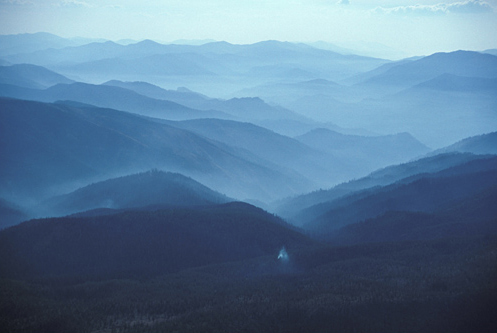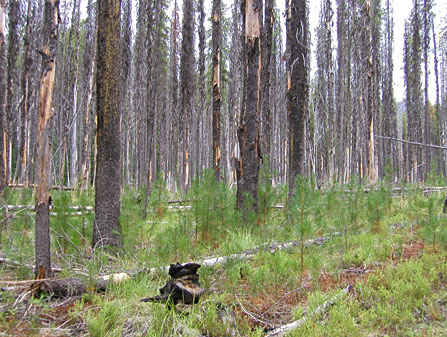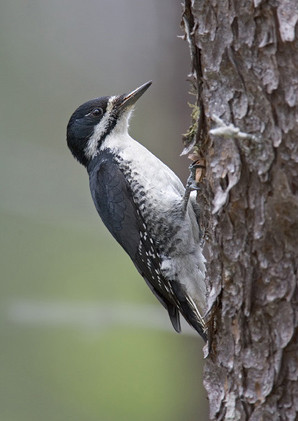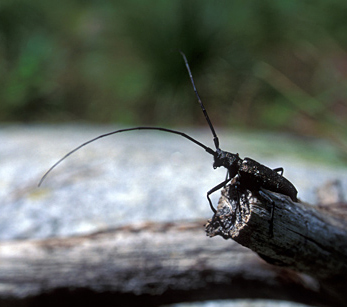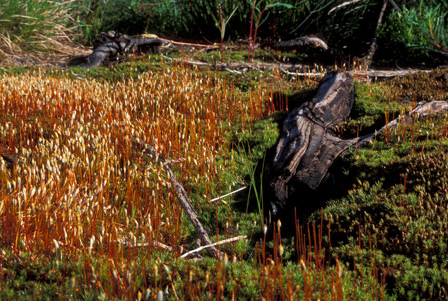Western lodgepole pine trees, a common tree in the Bitterroot Mountains, make up fire-loving forests. The burned areas crossed by the expedition were mentioned often in the journals.
Daybreak, mid-September in the Bitterroot Mountains during fire season, with lingering smoke from multiple large fires. At lower center a small cluster of trees bursts into flame in the morning calm.
The Lewis and Clark Bicentennial observance of 2003-2006 coincided with a period of especially droughty summers along the Northern Nez Perce Trail—K’useyneiskit, or Road to the Buffalo. Summer visitors to the high country are likely to see smoky horizons, or catch a whiff of smoke. Trees here are stressed from the continuing dryness of recent years. During our hot summers, forests dry out even more. With this region’s typical summer thunderstorms, dry lightning, and gusty winds, forest fires ignite and spread.
The word “fire” doesn’t appear much in Lewis and Clark’s journals during their wet and snowy trips along K’useyneiskit, except for a few references to Indians apparently having set fire to parts of the forest. But the phrases they repeated nearly every day—”thick timber,” “bad falling timber,” “more falling timber,” “innumerable logs of fallen timber,” and “emence quantity of falling timber which had falling from dift. causes i e. fire & wind”—are, really, all about fire.
Thick stands. Fallen trees on the ground. This is the look of western lodgepole pine forests, whose association with insect outbreaks and fire are well known to foresters and fire ecologists. Lodgepole pines, whose prodigious seed crops and sunlight-loving seedlings repopulate the very ground they burn upon, are today’s poster child for forests created by fire. Clark called them “pitch pines.”
Fire-loving Forest
These lodgepole seedlings began growing within a year or two after the pinecones that gave them birth opened from the heat of this “stand-replacement” fire. All the mature trees here were killed by the heat or flames of the fire; some of the dead snags have begun to fall over.
Today, along the higher elevations of K’useyneisskit’s cleared roadway, travelers may find themselves in living tunnels, their view blocked by thick stands of lodgepoles along the road. Beneath the look-alike trees lies a jumble of fallen dead snags, cast every which way like pick-up sticks, atop a bed of huckleberry bushes, whortleberry, and beargrass.
Dense stands of trees, nearly all of about the same age, result from the type of burn called “stand-replacement,” where all or most of the trees are killed by flames or heat, but persist as standing dead snags whose bark will loosen, whose roots will decay, and which will eventually topple and fall onto the forest floor. Some forests along K’useyneiskit are like this.
Lodgepole pine’s fire-adapted lifestyle, which amounts to replacing itself as a result of periodic fires, has long been well known. More recently, ecologists have brought to light other species’ relationships with fire. Fire scientists have found evidence of fires from past centuries or even millenniums by studying tree rings and charcoal deposits.
Many animals, insects, birds, and plants have evolved interesting adaptations to forest fires. The time span required for these adaptations is viewed as confirmation of fire’s ancestry in forest ecosystems. A woodpecker whose feathers may have evolved to match the blackened charred tree trunks on which it forages; insects armed with remote sensing equipment that guides them to recently burned forests: fire has been part of K’useyneiskit’s landscape for a long time.
Food for Birds and Insects
Black-backed woodpeckers travel long distances to find recently burned forests.
What’s behind the scenes in those endless stands of lodgepole pine along the mountain ridges of K’useyneiskit? Why would a bird evolve camouflaging feathers to blend in with burned forests? What purpose would heat sensors serve for a beetle?
The bird with black feathers is the black-backed woodpecker,[1]Picoides arcticus (Pik-OY-deez, “resembling a woodpecker”; ARK-ti-kus, “of the north”). one of eight Idaho woodpeckers that forage on wood-eating beetles in burned forests (Meriwether Lewis noted the hairy, Lewis’s, and pileated woodpeckers, and the northern flicker). Black-backs are drawn to the unique foraging opportunities in recently burned forests, and are able to detect them from great distances. They seek burned forests where most of the standing dead trees are nine inches in diameter or larger and still have bark, and where long, white, succulent larvae of wood-boring beetles belonging to the genus Melanophila (mell-ann-AH-fill-a, “black-loving”) live under the bark. A large supply of dead trees and beetles provides enough support for these specialized birds to mate and raise another generation. While raising a family, a black-backed woodpecker may consume over 13,000 beetles in a year.
Besides reducing populations of wood-eating insects, woodpeckers create nesting sites for many forest dwellers. Each spring, they excavate new nesting and roosting cavities in dead trees. The empty holes from previous years’ nests become available for the many species of birds and mammals called “secondary cavity nesters”–mountain bluebirds, chickadees, tree swallows, kestrels, flying squirrels, and pine martens, to name a few.
Insects that seek out forests stressed by fire are called “pyrophilic” (pie-row-PHIL-ik, “fire-loving”) and may have special sensors for detecting burned forests, even if they are many miles away. Some beetles have infrared sensors beneath their wings; others have smoke sensors on their antennae. The Air Force is intrigued by the superior capabilities of these sensors for detecting infrared radiation, and military research has furthered our knowledge of how they work.
New Growth
When we first see the newly burned ground surface of a stand-replacement fire, it appears as a desolate scene of ashy, burned soils with scattered remains of shiny, blackened, wood. But signs of life appear within a few weeks from “legacies” left by fire, like standing dead trees, isolated green trees, or surviving seeds and spores.
Seeds of nearby unburnt conifers blow onto the burned site. Exposed on the bare surface, they are easier to find and collect, and small mammals take advantage of this. Chipmunks can be seen scurrying around on ashy soil.
Roots that survive deep underground have sprouting potential. Grouse whortleberry[2]Vaccinium scoparium (vax-SIN-ee-um sko-PARE-ee-um), “broom-shaped blueberry bush.” reappears in this way. Its upper parts may be burned during a fire but if its roots survive in the soil, it can resprout. Its small shiny leaves carpet the floor of some of the lodgepole forests along K’useyneiskit, and its tiny, sweet, red berries are sought by grouse.
Lodgepole pine seeds sometimes come in “serotinous” (sir-AH-tin-us, “closed”) cones sealed with resin so thick that high temperatures, as from fires, are required for them to open and release seeds. This is one way that lodgepole pines can repopulate burned areas.
A closer look at the ground a year after a stand-replacement fire reveals some surprises. What’s a moss doing out in the bright sun? Some species of haircap moss[3]Polytrichum sp. (Poh-LIH-trih-kum), “many hairs or bristles.” The abbreviation “Sp.” stands for “specific epithet.” Every plant, animal, bird, insect, and fish has … Continue reading can colonize burned areas, appearing as a dark orange or red carpet of thickly growing plants.
Lewis and Clark didn’t mention smelling smoke from forest fires or seeing lightning during their trips through the Bitterroot Mountains in Idaho. But today’s summertime traveler probably will. Careful observers can search for clues to the interesting birds, animals, insects and plants that appear on the scene after a forest burns.
Content reviewed by Stephen F. Arno, Intermountain, Fire Sciences Laboratory, and Richard Hutto, University of Montana.
Further Reading
“Bird Conservation Plan: Burned Forest,” http://www.biology.umt.edu/landbird/mbcp/mtpif/burned.htm, (3 November 2003).
Richard L. Hutto, “Composition of Bird Communities Following Stand-Replacement Fires in Northern Rocky Mountain (U.S.A.) Conifer Forests,” Conservation Biology (October 1995), Vol. 9:5, pp. 1041-1058.
Evan Frost, “Of Wildfires and Woodpeckers,” Methow Naturalist (Summer 1996), Vol. 1:2, p. 1.
Mike Hillis, A. Jacobs, and V. Wright, “Black-backed Woodpecker Assessment” referenced by http://www.fs.usda.gov/Internet/FSE_DOCUMENTS/stelprdb5208271.pdf, pp. 43-45 (July, 2015).
Susan Milius, “Why Fly into a Forest Fire? It’s One Way to Meet a Lot of Great Bugs,” Science News (3 March 2001), V. 159, 140-141.
Deborah Richie Oberbillig, “Black-backed Woodpeckers Depend on Burned Forests” (September 2000), USDA Forest Service Northern Region News Release.
Sources
Stephen F. Arno and Rebecca P. Hammerly, Northwest Trees. Seattle: The Mountaineers Press, 1977.
“Forest Fire in the Northern Rockies,” http://www.northernrockiesfire.org/ (3 November 2003).
Roberta Parish, Ray Coupe and Dennis Lloyd, “Fire and Ecosystem Dynamics,” Plants of Southern Interior British Columbia. Vancouver BC: Lone Pine Publishing, 1996, p. 14.
Roberta Parish, Ray Coupe and Dennis Lloyd, “Lodgepole Pine,” Plants of Southern Interior British Columbia. Vancouver, BC: Lone Pine Publishing, 1996, p. 35.
Notes
| ↑1 | Picoides arcticus (Pik-OY-deez, “resembling a woodpecker”; ARK-ti-kus, “of the north”). |
|---|---|
| ↑2 | Vaccinium scoparium (vax-SIN-ee-um sko-PARE-ee-um), “broom-shaped blueberry bush.” |
| ↑3 | Polytrichum sp. (Poh-LIH-trih-kum), “many hairs or bristles.” The abbreviation “Sp.” stands for “specific epithet.” Every plant, animal, bird, insect, and fish has a pair of scientific names: first the genus name, then the specific epithet, much like our own paired names. When the specific epithet is uncertain, or when one is referring to several members of the same genus, “sp.” is substituted. |
Experience the Lewis and Clark Trail
The Lewis and Clark Trail Experience—our sister site at lewisandclark.travel—connects the world to people and places on the Lewis and Clark Trail.
Discover More
- The Lewis and Clark Expedition: Day by Day by Gary E. Moulton (University of Nebraska Press, 2018). The story in prose, 14 May 1804–23 September 1806.
- The Lewis and Clark Journals: An American Epic of Discovery (abridged) by Gary E. Moulton (University of Nebraska Press, 2003). Selected journal excerpts, 14 May 1804–23 September 1806.
- The Lewis and Clark Journals. by Gary E. Moulton (University of Nebraska Press, 1983–2001). The complete story in 13 volumes.
